How well do you know your knots? When you tie a leader to a fly, or a line to a leader, or a line to a reel, can you do it quickly, neatly and with confidence that it will stay tied, regardless of the materials? Not too many fishermen can, if the truth were known.
There's no need to learn a lot of knots, though it is a fascinating study. But a little time spent mastering a few of the more useful ones pays big dividends in fishing satisfaction, as well as easing the strain on the vocabulary :)
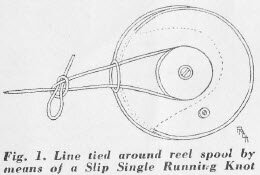 No claim is made that the particular knots described in this article are beyond dispute the best ones. Some of the finest fastenings are so difficult to learn, and so tricky to tie that only a few specialists ever become proficient enough to use them for everyday fishing.
No claim is made that the particular knots described in this article are beyond dispute the best ones. Some of the finest fastenings are so difficult to learn, and so tricky to tie that only a few specialists ever become proficient enough to use them for everyday fishing.
Knots have been selected which are easy to tie, yet are secure and workman-like. They may be used with confidence. The first need is for a means of fastening the line to the reel.
If the spool is slotted, it is necessary only to tie a plain Overhand Knot on the end and slip it into the slot. But if the spool is not slotted the line must be tied to it in such a way that it will be tight enough to permit winding, yet be easy to untie again.
A very satisfactory line-to-reel fastening is the Slip Single Running Knot, shown in Figure 1. To tie this knot, Pass the end of the line through the line guide, around the spool and back out again through the line guide.
With the end make a single bow knot around the line, pull it quite tight, and then draw the whole thing down taut against the spool. To remove the line, simply pull on the end and release the stopper loop.
Another excellent line-to-reel attachment consists of a short piece of line tied permanently to the spool, at the top end of which is made a long spliced loop, large enough to permit the coiled line, or storage reel, if one is used, to pass through it. If a small loop is spliced on the end of the line the reel loop may be pushed through this and over the line coil, then drawn up as in Figure 2.
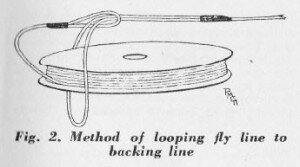 The same method may also be used to good advantage in making the working line fast to a running line, in which case the long loop is made on the end of the running line.
The same method may also be used to good advantage in making the working line fast to a running line, in which case the long loop is made on the end of the running line.
Fastening the line to the leader loop when the line is provided with a spliced terminal eye is accomplished in the same manner. This is undoubtedly the best and smoothest connection possible, but the splice should be examined frequently, as the constant bending eventually weakens the line at the base of the splice. See Figure 3. If there is no terminal eye, you will have to use a knot.
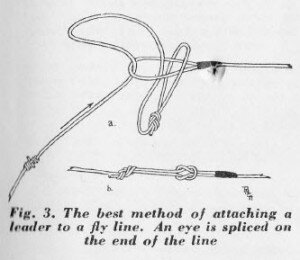 Of the many knots the most commonly used is the sailors' Becket or Sheet Bend. Figure 4a shows it as a line-to-leader fastening. It is so simple that instructions are unnecessary. The stopper knot on the end of the line is not needed if the Sheet Bend is well jammed, but is customarily added for extra security.
Of the many knots the most commonly used is the sailors' Becket or Sheet Bend. Figure 4a shows it as a line-to-leader fastening. It is so simple that instructions are unnecessary. The stopper knot on the end of the line is not needed if the Sheet Bend is well jammed, but is customarily added for extra security.
Figure 4b, the Slip Sheet Bend or Tiller Hitch is the same knot, except that it is stopped by returning the end to form a small loop. The advantage of this form is that it may be released readily by pulling on the end, and is just as safe, though it provides an additional bump on which the leader may foul.
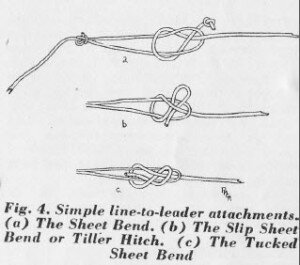 Both of the above knots are secure with gut, and reasonably so with Jap, but unsafe with Nylon or VEC. For use with these materials a slightly more complicated knot is desirable. The tucked Sheet Bend, Figure 4c, is entirely reliable and comparatively easy to tie.
Both of the above knots are secure with gut, and reasonably so with Jap, but unsafe with Nylon or VEC. For use with these materials a slightly more complicated knot is desirable. The tucked Sheet Bend, Figure 4c, is entirely reliable and comparatively easy to tie.
To tie the Tucked Sheet Bend first form an ordinary Sheet Bend loosely on the loop, then bring the end back over and thrust it under itself to form a Figure of Eight. In drawing it tight, see that the upper line loop does not pass through the leader loop. That would make another kind of knot, not so neat. Several similar knots are based on the Figure of Eight, some of them not very safe, so watch your step.
Apart from its greater security the Tucked Sheet Bend has the additional feature that the end of the line points toward the fly, so there is less tendency of the leader to foul the knot in casting.
Coming now to eyed-fly knots, again we find the versatile Sheet Bend, which, is usually known when so used as the Jam Hitch and other names (Figure 5). It is very simple, and reasonably safe with genuine gut if the tippet is a snug fit in the eye, but will not hold well 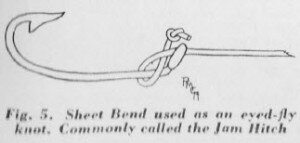 with Nylon, VEC or Jap. It is really uncertain, at best, though it is warmly recommended in angling books and catalogs. Our advice is to avoid it entirely unless you are familiar enough with its limitations to know with certainty when it may be safely used.
with Nylon, VEC or Jap. It is really uncertain, at best, though it is warmly recommended in angling books and catalogs. Our advice is to avoid it entirely unless you are familiar enough with its limitations to know with certainty when it may be safely used.
The Tucked Sheet Bend also is popular as an eyed-fly knot, and when so used is properly called the Wemyss Knot (pronounced "Weems") by many anglers the Figure of Eight, although it is only one of several having an equal right to that designation. Its construction is shown in Figure 6 the Wemyss Knots for Anglers.
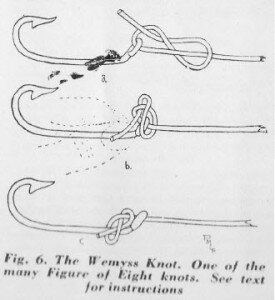 Probably the most satisfactory method of tying the Wemyss Knot is to pass the tippet through the eye of the fly and form a Figure of Eight around the standing part of the leader. The upper loop of the Figure of Eight is then pushed over the eye while pulling on the leader to close the knot. This should be a continuous motion, and so timed that the loop passes over the eye just before it becomes too small. The Figure of Eight will automatically turn over, and form itself in reverse on the shank.
Probably the most satisfactory method of tying the Wemyss Knot is to pass the tippet through the eye of the fly and form a Figure of Eight around the standing part of the leader. The upper loop of the Figure of Eight is then pushed over the eye while pulling on the leader to close the knot. This should be a continuous motion, and so timed that the loop passes over the eye just before it becomes too small. The Figure of Eight will automatically turn over, and form itself in reverse on the shank.
This sounds a little intricate. but is really very easy-so easy that one who uses it regularly has no trouble tying it in the dark.
Many anglers swear by, others at, the knot bearing the formidable title of "Major Turle's Eyed-fly Knot," usually contracted to "the Turle," or jocularly as "the Turtle Knot." The author has never cared greatly for this tie, as it is not only clumsy, slow and bulky but also wasteful of tippet stock. It is, however, comparatively easy to learn, as well as being fairly secure, at least with gut. While it is illustrated in the Nylon Knot Book there have been scattered complaints that it would not hold with Nylon. If tightly jammed it will undoubtedly hold, but as there seems to be a tendency on the part of fishermen not to jam it sufficiently, its use with Nylon is not recommended if you are in the habit of tying knots carelessly.
Click on more knots for anglers to read the rest of this article.